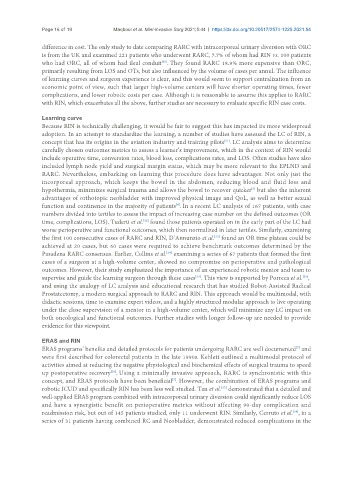Page 469 - Read Online
P. 469
Page 16 of 19 Maqboul et al. Mini-invasive Surg 2021;5:44 https://dx.doi.org/10.20517/2574-1225.2021.54
difference in cost. The only study to date comparing RARC with intracorporeal urinary diversion with ORC
is from the UK and examined 221 patients who underwent RARC, 7.7% of whom had RIN vs. 100 patients
[30]
who had ORC, all of whom had ileal conduit . They found RARC 18.9% more expensive than ORC,
primarily resulting from LOS and OTs, but also influenced by the volume of cases per annul. The influence
of learning curves and surgeon experience is clear, and this would seem to support centralization from an
economic point of view, such that larger high-volume centers will have shorter operating times, fewer
complications, and lower robotic costs per case. Although it is reasonable to assume this applies to RARC
with RIN, which exacerbates all the above, further studies are necessary to evaluate specific RIN case costs.
Learning curve
Because RIN is technically challenging, it would be fair to suggest this has impacted its more widespread
adoption. In an attempt to standardize the learning, a number of studies have assessed the LC of RIN, a
[31]
concept that has its origins in the aviation industry and training pilots . LC analysis aims to determine
carefully chosen outcomes metrics to assess a learner’s improvement, which in the context of RIN would
include operative time, conversion rates, blood loss, complications rates, and LOS. Often studies have also
included lymph node yield and surgical margin status, which may be more relevant to the EPLND and
RARC. Nevertheless, embarking on learning this procedure does have advantages. Not only just the
incorporeal approach, which keeps the bowel in the abdomen, reducing blood and fluid loss and
hypothermia, minimizes surgical trauma and allows the bowel to recover quicker but also the inherent
[5]
advantages of orthotopic neobladder with improved physical image and QoL, as well as better sexual
function and continence in the majority of patients . In a recent LC analysis of 167 patients, with case
[4]
numbers divided into tertiles to assess the impact of increasing case number on the defined outcomes (OR
[32]
time, complications, LOS), Tuderti et al. found those patients operated on in the early part of the LC had
worse perioperative and functional outcomes, which then normalized in later tertiles. Similarly, examining
[33]
the first 100 consecutive cases of RARC and RIN, D’Annunzio et al. found an OR time plateau could be
achieved at 20 cases, but 60 cases were required to achieve benchmark outcomes determined by the
[34]
Pasadena RARC consensus. Earlier, Collins et al. examining a series of 67 patients that formed the first
cases of a surgeon at a high-volume center, showed no compromise on perioperative and pathological
outcomes. However, their study emphasized the importance of an experienced robotic mentor and team to
supervise and guide the learning surgeon through these cases . This view is supported by Porreca et al. ,
[35]
[34]
and using the analogy of LC analysis and educational research that has studied Robot-Assisted Radical
Prostatectomy, a modern surgical approach to RARC and RIN. This approach would be multimodal, with
didactic sessions, time to examine expert videos, and a highly structured modular approach to live operating
under the close supervision of a mentor in a high-volume center, which will minimize any LC impact on
both oncological and functional outcomes. Further studies with longer follow-up are needed to provide
evidence for this viewpoint.
ERAS and RIN
ERAS programs’ benefits and detailed protocols for patients undergoing RARC are well documented and
[7]
were first described for colorectal patients in the late 1990s. Kehlett outlined a multimodal protocol of
activities aimed at reducing the negative physiological and biochemical effects of surgical trauma to speed
up postoperative recovery . Using a minimally invasive approach, RARC is synchronistic with this
[36]
concept, and ERAS protocols have been beneficial . However, the combination of ERAS programs and
[7]
[37]
robotic ICUD and specifically RIN has been less well studied. Tan et al. demonstrated that a detailed and
well-applied ERAS program combined with intracorporeal urinary diversion could significantly reduce LOS
and have a synergistic benefit on perioperative metrics without affecting 90-day complication and
readmission risk, but out of 145 patients studied, only 11 underwent RIN. Similarly, Cerruto et al. , in a
[38]
series of 31 patients having combined RC and Neobladder, demonstrated reduced complications in the

